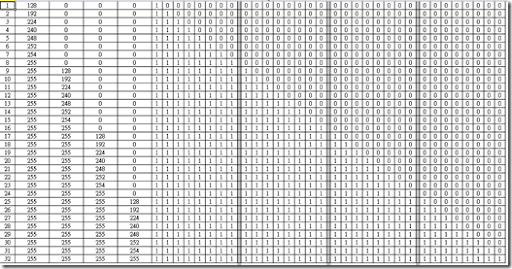


Pro Tip #2: Recognize the 9 possible values in any octet of a Subnet Mask The first 24 bits of the IP Address represent the Network ID, the remaining 8 bits represent the Host ID.ĭoes this mean that we need to convert a Decimal IP Address and Subnet Mask into Binary every time we want to figure out the network and broadcast address? Fortunately, the answer is no! We can quickly figure out the Network Address and Broadcast Address given any IP Address and Subnet Mask without ever needing to convert anything into binary! The Broadcast Address is the value when all of the Host ID bits are set to 1. The Network Address is defined by the value of the IP Address when all of the Host ID bits are set to 0. The remaining bits of the IP Address make up the Host ID. The number of 1s in the Subnet Mask define the portion of the IP Address that makes up the Network ID. The Subnet Mask consists of a string of consecutive 1s (from left to right) followed by a string of consecutive 0s to make up 32 bits. An IP Address and Subnet Mask combine together to define the network boundary. A block of 8 bits is often referred to as a byte - but more correctly as an 'octet'.Īn IP Address consists of 4 octets.

We use 8-bit blocks to store data in digital form. The same number (for example the number 123) requires many more digits to represent in binary (1111011 - 7 digits) than in decimal (123 - 3 digits).Ĩ binary digits (bits) can represent 256 different values (the decimal numbers 0 to 255). Pro Tip #1: Understand binary numbers - but don't get hung up on themĮach digit of a binary number can one of 2 values - 0 or 1. Given an IP Address and Subnet Mask, we want to be able to quickly determine the Network Address and Broadcast Address of the network defined by the IP Address / Subnet Mask combination. We can define our requirement as follows: Once we master this outcome, the other 2 outcomes mentioned above become much simpler to master. This post will focus exclusively on this outcome. This forms the basis of designing IP-based routed networks. Of the three outcomes we outlined above, identifying network boundaries is the most important one. Summarize a number of contiguous subnets into a single network.Break up a range of IP Addresses into a number of smaller ranges (subnets).Identify network boundaries (Network and Broadcast Addresses) from an IP Address and Subnet Mask.The first step in simplifying everything related to subnetting is to identify the key outcomes we are aiming for: Why are we writing a post on the topic? Our purpose is simply to demonstrate that subnetting is not as challenging a topic as it might sometimes seem. Why should we put in the effort to master subnetting? The answer is simple - it is essential to master subnetting if one wants to pursue a career in computer networking.


 0 kommentar(er)
0 kommentar(er)
